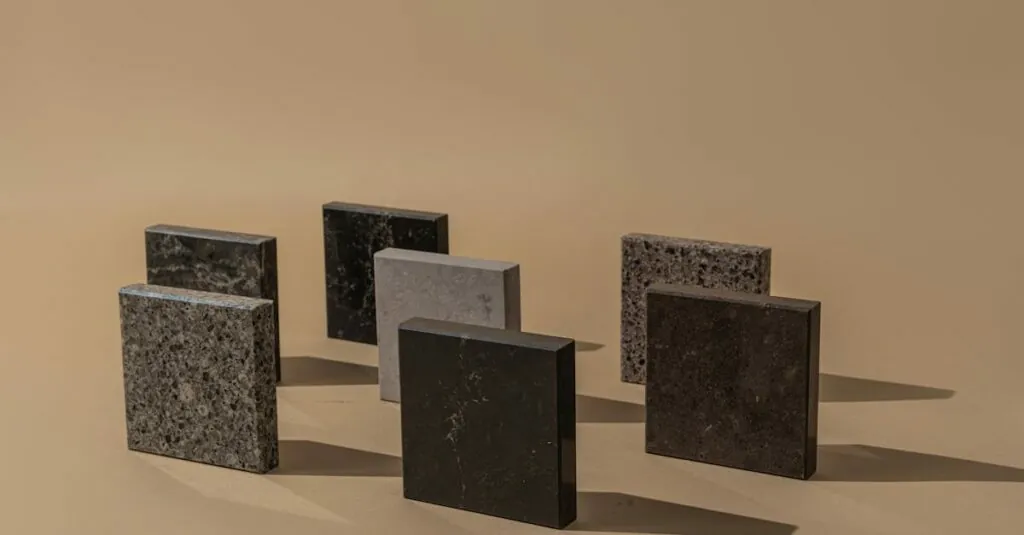When it comes to interior design, the right concept can turn a bland space into a vibrant sanctuary. Imagine walking into a room that not only looks good but feels like a warm hug from your favorite sweater. It’s not just about the furniture or the color palette; it’s about creating an atmosphere that reflects personality and style.
Table of Contents
ToggleOverview of Interior Design Concepts
Interior design concepts create the foundation for any successful space. Each concept emphasizes functionality while enhancing the aesthetic appeal. Popular themes include minimalism, bohemian, industrial, and traditional. Each theme connects various design elements to evoke emotions and convey individual styles.
Minimalism focuses on simplicity and cleanliness. It encourages the use of neutral colors, open spaces, and fewer accessories. By eliminating clutter, minimalism fosters a tranquil atmosphere conducive to relaxation.
Bohemian designs celebrate an eclectic mix of colors, textures, and patterns. This approach draws inspiration from different cultures, creating a warm and inviting environment. Layered textiles and unique decor pieces exemplify the personalization characteristic of the bohemian style.
Industrial design embraces raw materials and urban elements. Exposed brick, metal fixtures, and concrete floors create an edgy, modern feel. This style often incorporates vintage items, adding character and history to the space.
Traditional design reflects classic styles and timeless elegance. Rich wood tones, intricate moldings, and sophisticated fabrics define this concept. It’s perfect for those who appreciate symmetry and formal aesthetics.
Sustainable design emphasizes eco-friendly materials and practices. Choosing natural resources promotes environmental responsibility while enhancing indoor air quality. Incorporating plants also improves aesthetics and well-being.
Color theory plays a vital role in interior design. Colors can influence emotions and moods. Designers often use palettes strategically to achieve desired atmospheres. Warm colors like reds and oranges evoke energy, while cool colors such as blues and greens promote calmness.
By understanding various concepts, individuals can transform spaces according to their needs and personalities. Effective design fosters connection and harmony, making spaces truly feel like home.
Key Principles of Interior Design
Understanding the key principles of interior design transforms spaces effectively. Concepts such as balance, harmony, and focal points play vital roles in creating an inviting environment.
Balance and Harmony
Balance in interior design refers to the distribution of visual weight within a space. Achieving balance can occur through symmetrical arrangements, with equal elements on either side of a central axis. Alternatively, asymmetrical balance creates interest by distributing different elements, such as furniture, art, and decor, in a way that feels cohesive. Harmony complements balance by ensuring color schemes, textures, and styles work together cohesively. When space harmonizes, each element contributes to an overall aesthetic, promoting comfort and visual appeal. Using complementary colors, similar materials, and consistent design themes establishes a cohesive feel, making the environment more inviting.
Focal Points
A focal point draws attention and can be anything from a striking piece of art to a stunning fireplace. Establishing a focal point serves as a conversation starter and enhances the room’s purpose. Strategically arranging furniture around this element creates flow and guides movement throughout the space. Heavily decorated areas demand simpler furnishings to not overshadow the focal point, allowing it to shine. Utilizing lighting also highlights focal points, transforming ordinary spaces into extraordinary ones. When each area of the room contributes to the focal element, the design achieves a unified, visually appealing aesthetic.
Popular Interior Design Styles
Various interior design styles create unique atmospheres that reflect personal tastes. Understanding these styles enhances the effectiveness of designing spaces.
Modern Minimalism
Modern minimalism embodies simplicity and functionality. This style emphasizes open spaces and a limited color palette, often featuring whites, grays, and earth tones. Essential furniture pieces focus on clean lines without excessive ornamentation. Natural light becomes a critical element, promoting a sense of tranquility. Decor seldom distracts from the core design, allowing each piece to serve a purpose. Minimalism also enhances spatial harmony by reducing clutter, making environments feel serene and inviting.
Bohemian Chic
Bohemian chic celebrates a free-spirited aesthetic. It thrives on an eclectic mix of colors, patterns, and textures, promoting individuality. Textiles play a significant role, with vibrant rugs and layered fabrics adding warmth and character. Plants and natural elements enhance the lively atmosphere, creating a connection to nature. Artistic accessories such as handmade crafts and unique finds contribute personality to each room. This style inspires creative expression, allowing spaces to convey personal stories through curated collections.
Industrial Design
Industrial design showcases raw materials and urban influences. Exposed bricks, metal beams, and concrete floors define this style’s rugged charm. Open layouts maximize available space while highlighting architectural features. Neutral color schemes often complement the industrial elements, creating a cohesive look. Vintage furnishings and repurposed materials add character and enhance the overall design. Lighting fixtures, like Edison bulbs or pendant lights, contribute to the industrial vibe, emphasizing functionality while maintaining style.
Color Theory in Interior Design
Color theory plays a significant role in interior design, influencing emotions and setting the atmosphere of a space. The psychological impact of color can evoke feelings such as calmness, excitement, or warmth. Designers utilize color palettes strategically to create desired effects, enhancing visual appeal and comfort.
When selecting colors, consider the principles of color harmony. This concept focuses on creating a balanced and cohesive look by selecting colors that complement each other. For instance, analogous colors, which are next to each other on the color wheel, provide cohesion while allowing for variety. Likewise, complementary colors, located opposite each other, generate contrast and vibrancy within a design.
Exploring the emotional associations tied to color provides valuable insights. Blue often promotes tranquility and serenity, making it ideal for bedrooms. In contrast, red tends to stimulate energy and passion, suitable for entertaining spaces like living rooms. Yellow, known for its brightness, can create feelings of happiness and warmth, enhancing kitchens or dining areas.
Designers may also consider the effects of light on color. Natural light alters how colors appear throughout the day, while artificial lighting can change their perception at night. Different finishes, such as matte or glossy, also affect how colors reflect light, impacting overall ambiance.
Ultimately, incorporating color theory into interior design aids in crafting spaces that feel personalized and inviting. By understanding how colors interact and influence emotions, individuals can develop environments that resonate with their unique style and enhance their day-to-day experiences.
Space Planning and Layout
Space planning ensures efficient and functional use of a area. This process involves organizing furniture, fixtures, and traffic patterns to enhance usability. Designers first assess a space’s size and shape, considering how people interact within it.
Creating a detailed layout promotes flow and accessibility. It incorporates elements such as zoning, which divides a room into specific areas for different activities, optimizing comfort and function. Designers often use furniture arrangements to create inviting areas that encourage social interaction.
Understanding dimensions also plays a crucial role in layout design. For example, maintaining appropriate clearances around furniture prevents overcrowding and allows for easy movement. Measurements for pathways should typically range from 24 to 36 inches, ensuring ample space for navigating.
Incorporating flexibility into space planning allows the environment to adapt to various needs. Modular furniture offers rearrangement possibilities, catering to different occasions and preferences. Designers often prioritize multifunctional pieces to maximize limited space.
Using software tools, designers visualize layouts before implementation. 3D modeling assists in testing arrangements and understanding spatial relationships, saving time and resources. Engaging with clients during this phase fosters collaboration, ensuring their input shapes the final design.
Overall, effective space planning and layout support the overall vision of interior design. By balancing aesthetics and functionality, these practices create environments that resonate with personal style while meeting practical needs.
Interior design concepts play a crucial role in shaping environments that reflect personal style and enhance comfort. By understanding various themes like minimalism, bohemian, and sustainable design, individuals can create spaces that resonate with their unique identities.
The principles of balance, harmony, and focal points further guide the design process, ensuring that every element works together cohesively. Incorporating color theory and effective space planning not only elevates aesthetics but also improves functionality.
Ultimately, a well-designed space fosters connection and harmony, making it a true reflection of what home means to each individual. Embracing these concepts empowers everyone to transform their surroundings into inviting and personalized havens.





